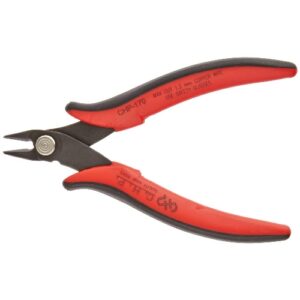
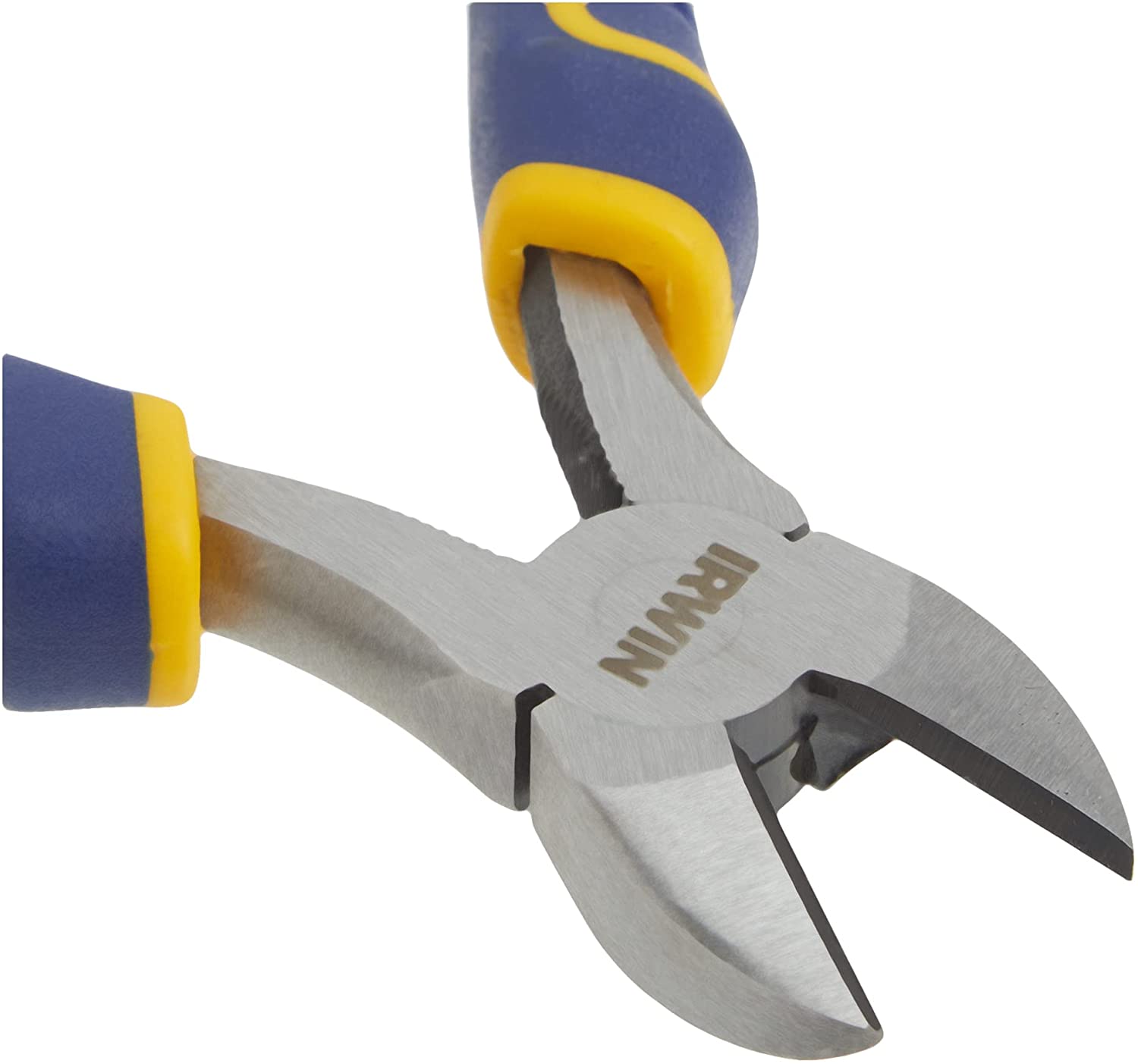
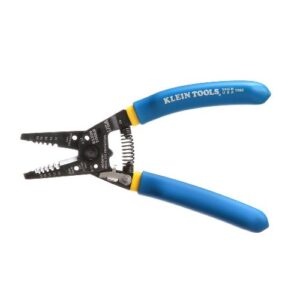
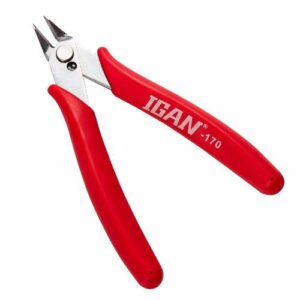
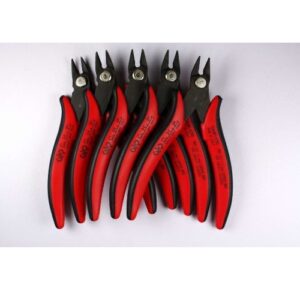
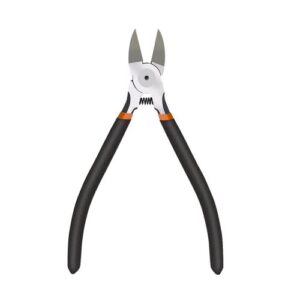
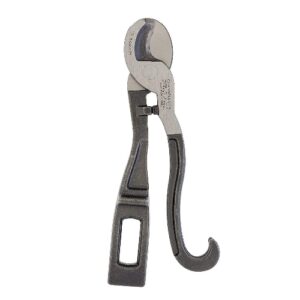
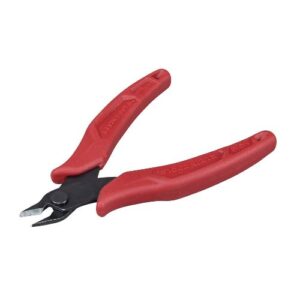
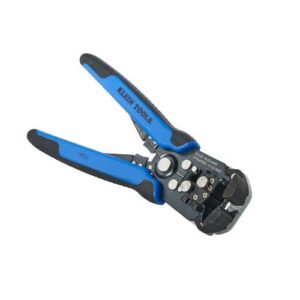
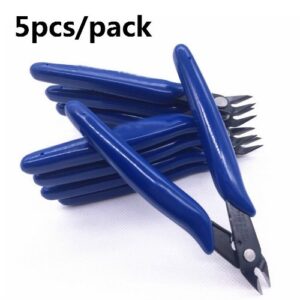
Customer’s Choice: Rated Best Wire Cutters
[survey_answers id=”363829835″ style=”plain” data=”score”] users answered this survey. Please help us improve this review!
[survey_answers id=”363829835″ style=”piechart” legend=”true”]
Hobbyists who seek durable and safe tools for their electric DIY projects and professional electricians – all these people at some point need wire cutters. It is easy to guess what you can do with this instrument – wire-cutting. These tools are so simple that even beginners can easily use them when working with live wires.
However, only high-end tools deliver such usability. The following guide reviews the most popular wire cutters and what factors to consider when buying these instruments.
Hakko Micro Cutters – the best for the size!
 The Hakko micro cutters can be great for their cost. They are really irreplaceable if you need to cut the thin soft wires quickly and effortlessly. This is a palm-friendly tool with many features to like. This very small instrument is capable of cutting the wires up 16 gauge (mostly copper and soft plastic).
The Hakko micro cutters can be great for their cost. They are really irreplaceable if you need to cut the thin soft wires quickly and effortlessly. This is a palm-friendly tool with many features to like. This very small instrument is capable of cutting the wires up 16 gauge (mostly copper and soft plastic).
Pros
- Lightweight
- Small in size
- Long micro jaws
- Budget-friendly
- Convenient
- Flush-cutting technology
- Anti-glare and anti-corrosion finish
Cons
- Not good for cutting hard wires
- Not durable – do not push too hard
This instrument has dolphin-style non-slip grips and Parkerized finish to prevent any glares. It has a special spring mechanism to protect hands from cutting. It can be used as a pcb depaneling tool, in a pinch!
IRWIN VISE-GRIP Wire Cutters – 6 inch grip!
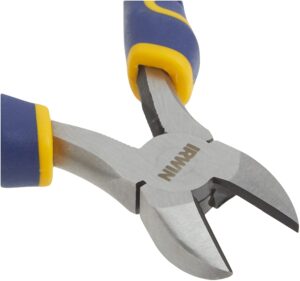 This versatile tool offers a bit more than wire cutters. Besides the wire-cutting, the Irwin Vise-Grip locking pliers can strip and crimp the wires.
This versatile tool offers a bit more than wire cutters. Besides the wire-cutting, the Irwin Vise-Grip locking pliers can strip and crimp the wires.
So, many electricians may find this instrument very useful. Apart from any wire-cutting and stripping, you can snip bolts and screws with this tool.
However, you should not pick these pliers for strength.
Pros
- The 3-in-1 tool – wire cutters, wire strippers and crimper
- Affordable
- Good quality
- Curved jaws hardened teeth for better visibility and use
- Heat-treated steel alloy
- Controlled release and instant lock
- Knurled tips
Cons
- Not durable
- Bulky
- Super-hard jaws – no smooth action
- Can’t cut through hard wires
The tool includes a classic guarded trigger for the maximum locking force. They are also available in sizes – from 4 to 9 inches. You may use this instrument for a very precise job in tight places – turning, clamping and twisting.
Klein Tools 11055 – the best for working at night!
 This instrument has the so-called Klein-Kurve design for cutting solid and copper wires. Besides the decent cutting, this tool can glow in the dark. It is a great feature if you need to work at night with bad lighting or in narrow tight places where there is not enough sunshine.
This instrument has the so-called Klein-Kurve design for cutting solid and copper wires. Besides the decent cutting, this tool can glow in the dark. It is a great feature if you need to work at night with bad lighting or in narrow tight places where there is not enough sunshine.
You can cut through solid and stranded wires made of plastic or copper. The nippers are double-dipped for extra hand comfort.
[tds_info]Tips for users: With this tool, you can shear 6-32 and 8-32 screws. And this tool won’t be able to strip the conductors covered with a thin plastic jacket.[/tds_info]Pros
- Compact
- Made in the USA
- Lightweight
- Precision stripping holes
- Awesome style – glows in the dark
- Double-dipped grips with curved handles
- Quick self-opening action via a coil spring
- Easy-to-read markings on the tool
Cons
- Won’t protect from rust
- Not very sharp
- Not durable
This tool has a serrated strong-grip nose for simple bending, snapping, and pulling of wires. It can cut any 10 and 12 gauge wires made of copper.
IGAN-170 – the best for ultra-cutting!
 The IGAN-170 wire cutters are good for precision electronic flush cutting. They are sharp, durable and easy to use. If you seek the tool capable to do fine and ultra-fine wire-cutting jobs, consider choosing the IGAN-170 cutters.
The IGAN-170 wire cutters are good for precision electronic flush cutting. They are sharp, durable and easy to use. If you seek the tool capable to do fine and ultra-fine wire-cutting jobs, consider choosing the IGAN-170 cutters.
Pros
- Compact design
- The open spring mechanism with protection
- Very sharp
- Good for working in tight places
- Hand fatigue relief
- The flush cutting tech
- Durable – made from stainless steel
Cons
- Not good for cutting hard or big gauge wires
- No lifetime warranty
Also, you should check this instrument if you look for environmentally friendly cutters made of TPE material. They are non-toxic for pets and kids. The handles have a rubber-like structure.
Hakko CHP Micro Cutter – the best price!
 The Hakko CHP micro wire cutters are recognized for clean cuts. This instrument can cut through any 16 AWG wires. This particular item includes not 1 but 5 identical wire cutters for the best price in the U.S. market. Their Rockwell hardness (arch) is 56 due to the basic material – hardened carbon steel.
The Hakko CHP micro wire cutters are recognized for clean cuts. This instrument can cut through any 16 AWG wires. This particular item includes not 1 but 5 identical wire cutters for the best price in the U.S. market. Their Rockwell hardness (arch) is 56 due to the basic material – hardened carbon steel.
Pros
- The best price
- Micro cutting tips
- Flush-cutting tech
- Can cut through 15 AWG wires
- Ergonomic handles
- Made of carbon steel
- Small but durable
Cons
- Cheap and can be broken if you push too hard
- Not good for most wires and cables
You may pick the Hakko CHP micro cutters for their compact size and long micro tips capable of cutting very fine wires. This instrument may perfectly help with small but delicate electronic jobs.
The Buyer’s Guide
Wire cutters are a simple tool used for small daily tasks, especially if you frequently do electrical jobs. Wire-cutting can be much simpler and safer if you apply this small and useful instrument. And here are a few factors you should consider and check before buying wire cutters:
The wires the tool can cut
The most important feature of a wire cutter is… well, its ability to cut the wires. Check the specifications pointed out by the manufacturer before buying. Most tools from the list can’t handle hard and stranded wires or thick cables. They are better for delicate jobs like repairing electronic gadgets, jewelry making, cutting through copper wires. Only very heavy and durable instruments can cut tempered steel wires like piano wires.
Design
Like any instrument, the wire cutters should be comfortable. The best job is achieved with sharp blades and grips. Spend a few dollars more to invest in a really durable tool made of carbon steel or stainless steel.
Head cutters
You need to make sure that the cutters can be great for precision, quick and accurate cuts. Look for the tools with advanced flush-cutting technologies, micro tips and good springs for better locking.
Blades
The main reason to buy wire or cable cutters is to help people to deal with cutting the wires safely. The blades must be really sharp and their angle cut, center cut, clipper cut and shear cut should be great as well. Check if the cutters have clean and sharp blades from the first use. Never take the pliers with dull blades because you may hurt yourself.
Handles
The cheapest cutters and nippers have the handles made from polymer and plastic. For most models, the manufacturers use really hard plastic covered in the rubberized casing. The grip should be comfortable to grasp even if your palms are oily or wet. It wouldn’t hurt if the tool has heat-resistant handles. The ergonomic shape can help to avoid hand fatigue.
Price
Typically wire cutters are budget-friendly tools – the highest cost is no more than $20. Despite multi-purpose instruments, you can buy high-end nippers at any time. Price is not the major factor to consider at this point.
How to use the wire cutters?
- Position the tool at a right angle when cutting the wires;
- It is not recommended to push too hard on the handles. Nippers need to be carried carefully to prevent the jaws from snapping;
- When working with such a tool, it is necessary to monitor the process of cutting. If there are people nearby, it is necessary to point the tool away from them to prevent any damage;
- If you need to cut a thick wire, then it is advisable to perform this delicate job only with the precision tips of the cutters;
- When you do the wire-cutting, the cutting edges should close completely. If the jaws begin to diverge to the sides when closed, then work should be stopped. Otherwise, the cutting part of the tool may break;
- When working with powerful large cutters, it is advisable to resort to the help of a second person who will support the wires and put them in a safe place. Such situations usually happen in the workplace. For small jobs you won’t need any assistance;
No matter, if you just do the soldering works occasionally or regularly; it will be hard to avoid the part of cutting the wires. That is when high-grade wire cutter can save the day.
This small but handy tool is capable of slicing any wires to the preferred number of pieces in mere seconds. However, many cheap cutting tools are only worth skipping. I added this review with one clear purpose – to help everyone who wants to invest into a top-notch, durable instrument.
The rating of these cutting instruments gives the unbiased opinion on the best appliances in this narrow niche. I assure you that any of the offered tools will cut more than the thickest wires and go easily through hardware clothes, wire ties, welded fences and finish nails.
The best wire cutters for any maintenance and electrician jobs:
- Micro is very soft, with the “dolphin style”;
- IRWIN VISE-GRIP has a curved jaw and classic trigger I like so much;
- Klein Tools 11055 is very durable, has holes for looping;
Other U.S. and foreign brands of cutting tools for wires that I can strongly recommend: IGAN, Hakko, BOENFU, Channellock, Flush, Klein Tools, and KAHIOE.
In the light of the above-mentioned criteria, I would like to say that even the best instruments shouldn’t cost more than $20. Keep in mind that this and other SolderingIronGuide reviews are posted with occasional updates. I also make sure to add video tutorials to simplify the choice.
FAQ Wire Cutters
How should you use a wire cutter tool?
A wire cutter has a sequence of labeled holes in whatever form the instrument takes, which match the common types of wire gauges – typically, 10-gauge to 20-gauge. It exactly severs through the plastic insulating material without destroying the copper wire when you input the wire into the proper hole and pull the handles of the tool. The device then eliminates the wire insulation, using one of two techniques.
It’s important to note that either solid or stranded forms of copper wire are commonly available. In diameter, stranded wire is slightly larger than solid wire of the same gauge. Wire cutters frequently have two sets of numbers indicating the sizes of the cut holes, for this reason.
The hole marked for 10-gauge solid wire, for instance, needs the same crevice you should use for a 12-gauge stranded wire. Each time make sure that you use the right set of markings for the type of wire that you are cutting.
Even though various manufacturers offer multiple variations of the tool, with each instrument, the method for removing wires is largely the same.
For the conventional or combination-style tool, use such a cutting technique:
- Decide the gauge and type of cable. The gauge of the copper wire to be removed is known. You will find this within an NM cable on the outermost sheathing that links several wires together. For starters, with a number such as 12/2, the wire gauge (in this case, 12) is the first number. Note also if strong or stranded copper is the wire;
- Fit the wire to the instrument. Match the wire gauge with the hole on the wire stripper that is correctly numbered. This step is important: if you choose a hole that is too large, it will not totally cut the insulation and you will have a hard time stripping it; if you pick a hole that is too short, the wire may be completely nicked or even severed;
- Open the tool and put the wire in place. Open the handles of the wire stripper. “Place” the wire through the correct hole on one foot. Push the handles together gently until they can’t move any farther. The insulation on the wire will cut through the action;
- Optionally twist. If the wire insulation is not fully cut, the wire inside the hole (or the wire stripper across the wire, whichever is easier) can have to be carefully rotated. You don’t have to rotate far: in one direction and back, only a quarter turn;
- The insulation strip. To remove the insulation, force the wire stripper into the cut end of the wire. The movement is like taking off a sock. Applying the thumb on the hand that is holding the wire, some users find it easiest to drive against the instrument, while the other hand keeps the tool handles tightly shut;
You should remove the insulation as the wire goes through the slot. If the striping tools are dull, until the insulation is entirely severed, they may need to be rolled around or back and forth.
How should you open a wire cutter?
Open the cutters’ jaws and insert the wire’s end into the corresponding slot. There are two sets of labels in each slot indicating the different sizes because solid wire’s external dimension is not the same as stranded wire. Clamp down on the wire with the jaws and drag.
Is it safe to cut a cable wire?
Cables and telephone wires do not bear current, so cutting them is safe. It’s critical, however, not to cut into a power line. For instance, if it is a plain old coaxial cable applied for cable TV, and you are sure that you will not use it and that the coverage has been fully disconnected, also, it will not break any lease or occupancy conditions, you may be able to use wire cutters to cut it.
Can you cut an unplugged wire?
Yeah. Yes, you can. Using a cutter for wire, pliers or a simple pair of scissors. If it used to be a power cable, you need to make sure there is no power flowing through at first. You may patch it with shrink tubing if the casing on your cable loses touch. A couple of pieces of shrink wrap tubing that are 1.25 inches long are carefully cut. Place a little silicon adhesive on where the connections on either end cross the thread.
Slip the tubing over the wire until the silicon dries, protecting all ends where the cord reaches the connectors. Through placing it over a lighter, rub the remaining silicone off and shrink the tubing. Make sure that the lighter is not too close to carry. You don’t want the rope to melt. Try using a blow dryer at the maximum heat setting to shrink the tube if using a lighter scares you.
Are pliers and wire cutters the same instruments?
Many people find it hard to differentiate diagonal pliers from other methods for cutting. The distinction between diagonal pliers and curved wire cutters is generally not understood to them. Pliers are hand-held devices used to firmly grasp and retain objects, as well as to cut and bend certain material, such as metal. It is necessary to use the jaws of a pair of pliers since they are intended to manage some things that might be too fragile for you to carry with your fingertips.
To break a wire, diagonal pliers are specifically needed. They have different titles, like side pliers, side-slashing pliers or needle-nose pliers. As there are several various types of pliers, people are typically puzzled because each form should be used for one or several occupations. For its intersecting teeth, these pliers are called split wire at an angle. They can’t only cut the metal, unlike pairs of scissors, but they also form indentations and wedges in the wire.
Can wire cutters cut through metal?
The wider the shears, the longer the cuts they’ll create with any form of metal-cutting shears. Electric shears have teeth in a vertical motion that operate. At a fast speed, these shears allow straight cuts into metal. A V-shaped blade that snips great dovetails has Dovetail wire cutters. These heavy-duty cable cutters are constructed of durable reinforced steel and can be used for both cutting 1⁄4-inch stainless steel and galvanized aircraft wire cables.
Diagonal wire cutters usually have diamond-shaped tips, may be used for wire and metal cutting, and are applied by carpenters as well as electricians.
How do you remove a wire without a wire cutter?
If no cutter is available, it’s feasible to apply a hacksaw to cut wire. For as clean a cut as possible, you’ll want to apply a blade with a high teeth-per-inch (TPI) number. Using a hacksaw to cut wire is difficult, regardless of the TPI count, unless the wire has a large diameter.
Video Tutorial: 6 Ways How to Strip Wire
Final thoughts
Wire cutters are quite handy instruments. They are budget-friendly and more versatile than basic pliers are. If you do many electrical jobs and have to isolate the wires, you should definitely invest in durable wire cutters. Look for the multi-purpose tools that are made of high-quality metals.

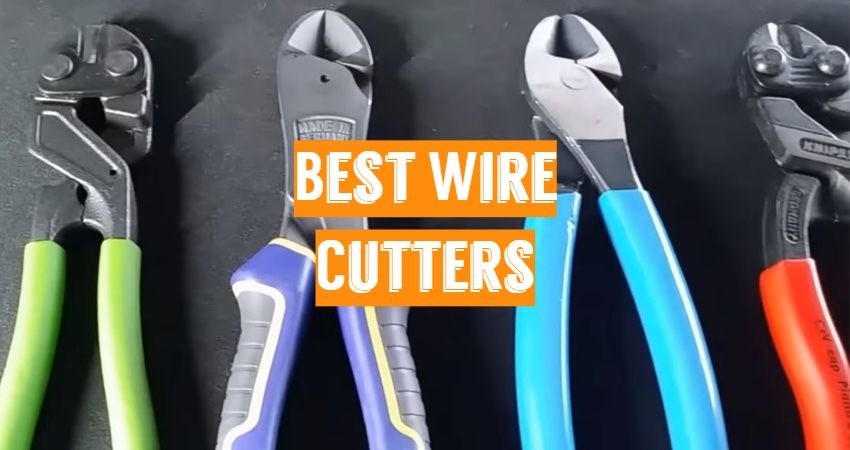

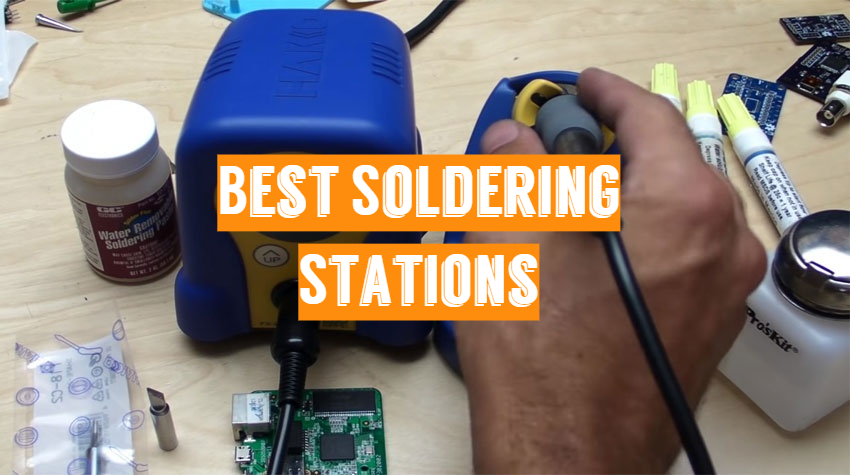
I have so many pairs of wire cutters, yet I feel like you can never have enough. This is a good list of ones to get nearly anyone started. I have a pair of soft wire cutters and curved jaw cutters. Together, those two can accomplish pretty much whatever I need for most projects.
Hi, my friend! Thanks for your comment.
By far the Micro Cutter is the best wire cutter anyone could buy. I’ve been using one for a while now and have found no flaws. It simply works well and stands the test of time. It’s a great tool if you are in need to cut a lot of wire quickly and efficiently.
Wire cutters are simply a must if you plan to be working with wires regularly. Often times wires come in large packs where they give you length instead of exactly what you need. Therefore, you should prepare yourself for this by getting one of these wire cutters.
Hello, Brad! Thanks for sharing your experience.